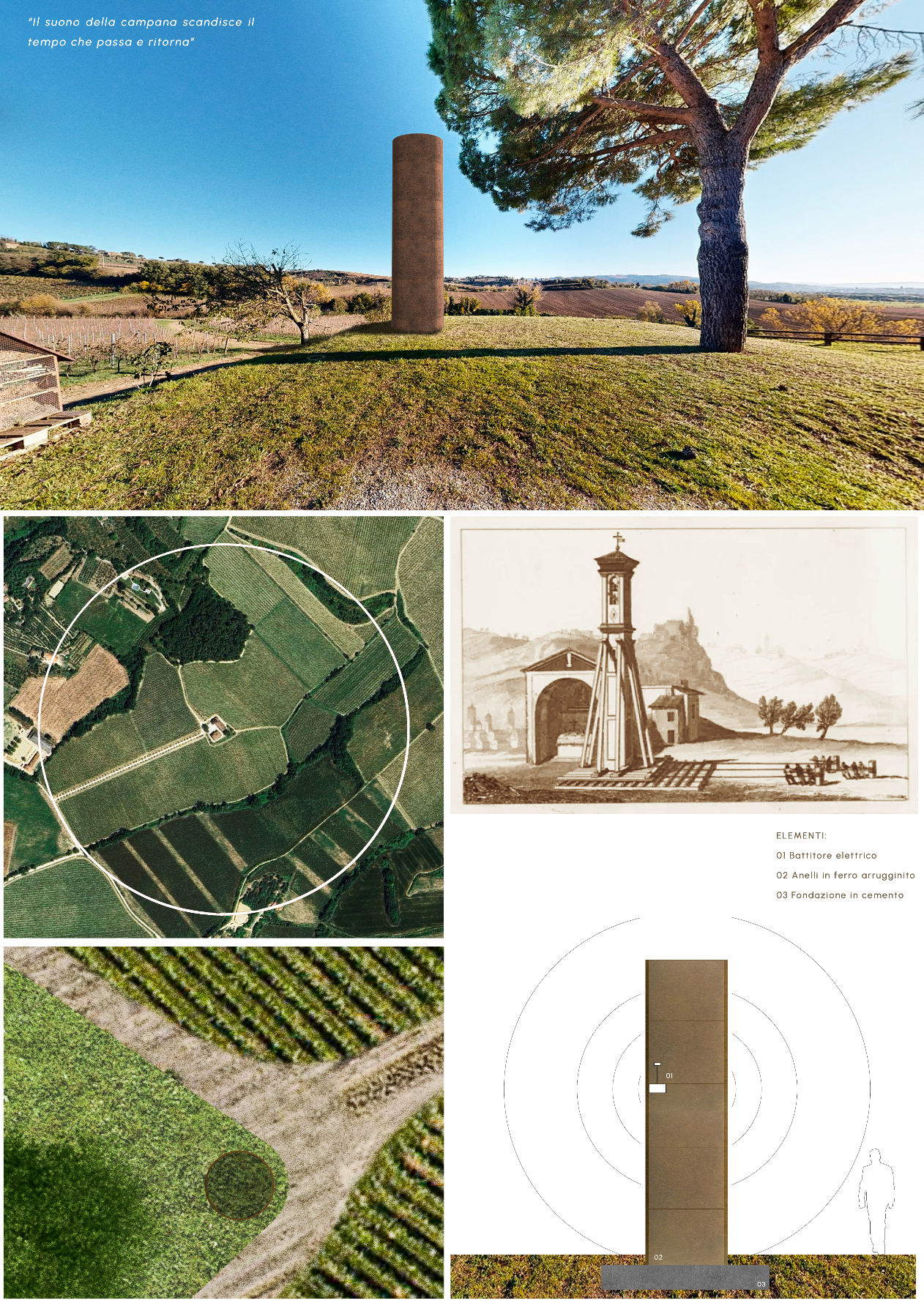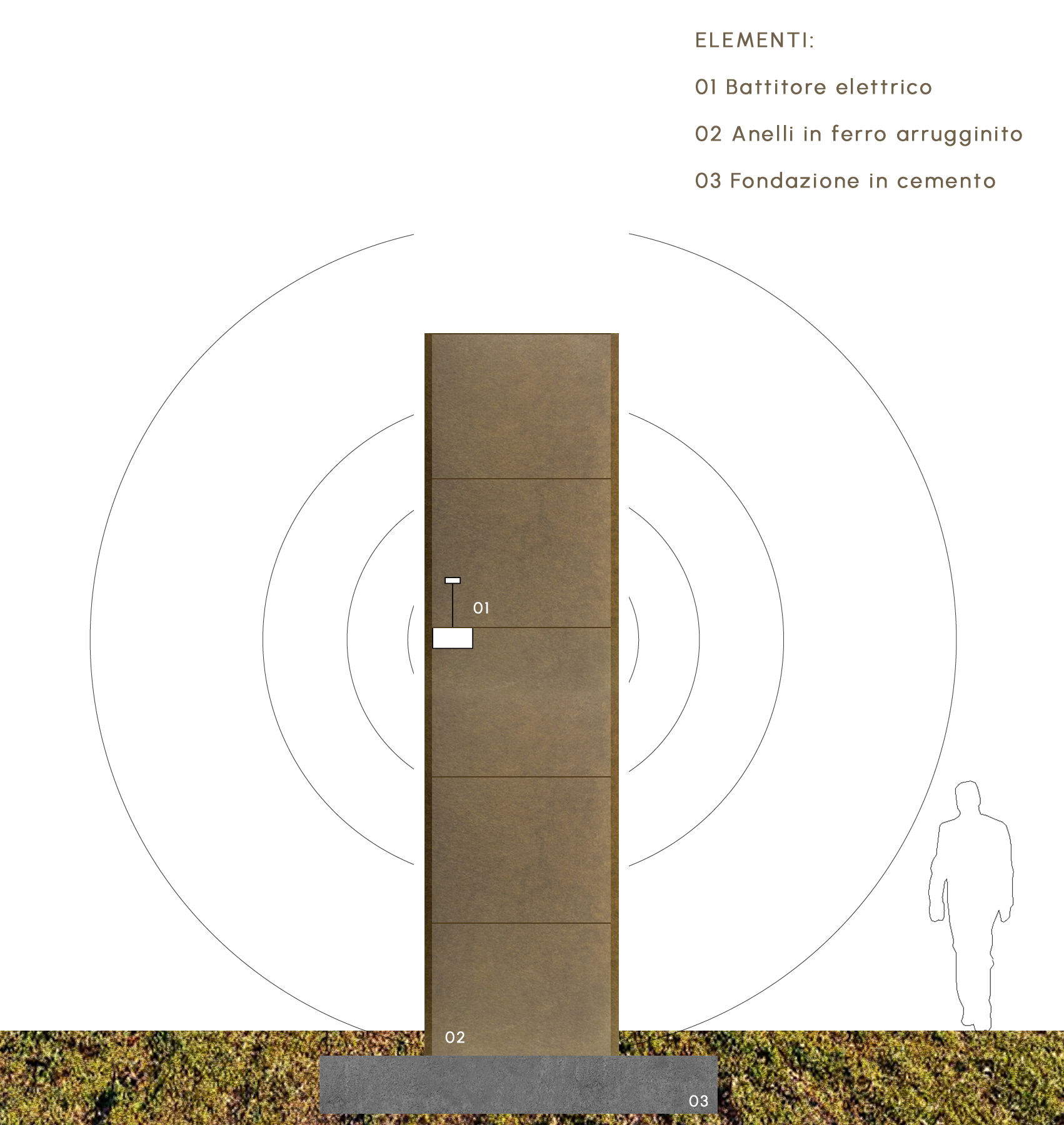Lorenzo Guzzini (Recanati, 1983) is the winner of the 11th edition of the Cramum Prize for Contemporary Art. An architect and artist, he won the award with the work Linear Time and Cyclical Time, a five-meter-high contemporary bell tower designed as a site-specific sculpture and intended to be permanently installed in the park of the Cantina Terre Margaritelli winery in Umbria.
The award ceremony was held June 26 at the Listone Giordano Arena in Milan, a space that is increasingly shaping up as a meeting point for art, architecture and culture in Italy’s economic capital. The Prize, curated and directed by Sabino Maria Frassà, was realized in collaboration with Listone Giordano and Terre Margaritelli. The theme of the 2025 edition, The Time of the Earth, was addressed by ten finalists from different creative fields: architecture, art, design and scenography. Guzzini’s winning work was selected by the jury chaired by Andrea Margaritelli, who also awarded two special mentions to artists Livia Paola Di Chiara and Marco Paghera. The decision matured considering the high level of the finalist works and the large number of nominations received.

"Lorenzo Guzzini’s work Linear Time and Cyclical Time interprets the theme of the edition with sensitivity and visual power,“ the jury explained, ”addressing time as a double dimension: linear for human beings, cyclical for nature. The bell tower fits with sober authority into the landscape, becoming a visual and sonorous reference. The daily chiming at noon evokes a geography of existence, recalling the balance between work and contemplation, between matter and spirit. Designed to mature with place, the work fully represents artistic maturity: a synthesis of experience, awareness and generative capacity. An art that is resistant to the ephemeral, rooted in time, the land and the community."
In addition to the symbolic recognition, Guzzini received the iconic cramum cube, designed in 2012 by Antonio Frassàandmade for this edition in European cherry wood by artisan Mario Rossi.
“With Linear Time and Cyclical Time,” says Sabino Maria Frassà, director of the Prize, “Lorenzo Guzzini continues his research on the relationship between essential form, matter and perception, where architecture and art merge into a single language. In this work, time is not represented in an abstract way, but restored as a concrete, everyday experience. If for the human being time is perceived as linear, the earth, as Guzzini shows, lives it according to a cyclical rhythm, marked by the return of the seasons and gestures that nourish and regenerate. The contemporary bell tower he imagined stands out in the Umbrian landscape as a silent but constant presence: vertical, essential, listening. Its daily tolling at noon becomes ritual, orientation, shared memory. As John Donne wrote: ’Never ask for whom the bell tolls: it tolls for you.’ It is not a nostalgic sound, but an invitation to stop, reflect, remember who we are. It evokes the rhythm of the ora et labora, and reconnects us to a more human and natural time. Giacomo Leopardi’s echo also resounds in that chime: ’The bell rang in the daytime. The echo returned like a cuckoo in the valley.’ The very material of the work, alive and marked by time, confronts its pure form, in tension between toil and spirituality. For, as Ernest Hemingway recalled, echoing Donne: ’For whom does the bell toll? It tolls for you.’”
“We are proud of the wide participation and selection of ten finalists, diverse in age but united by a profound and unconventional worldview,” says Jury President Andrea Margatelli. “Like the land that inspires us, art, as well as architecture and design, must be able to embrace change, not fear it. Lorenzo Guzzini’s work embodies this principle with strength and measure. Only that which grows slowly, settles meaning and identity, can reveal its authenticity and most enduring value over time.”
The ten finalists selected for the 11th edition were: Luca Antonio Bonifacio, BohoB (a collective composed of Marialaura Calogero, Matteo Pennisi and Graziano Testa), Margherita Burcini, Livia Paola Di Chiara, Lorenzo Guzzini, Marco Nones, Marco Paghera, Andrea Papi, Giulio Rosi and Alfredo Vanotti, the latter in collaboration with Fabio Sciuchetti. In addition to Frassà and Margaritelli, the jury of the 11th Prize was composed of Tiziana D’Acchille, Franco Mazzucchelli, Fulvio Morella, Marco Tortoioli Ricci, Carla Tolomeo and Luca Zevi.


Lorenzo Guzzini is an architect and artist. His research interweaves art and architecture, focusing on matter and essential geometries, interpreted through the elements and ideas that originate them. Each sphere dialogues with the other: his work is based on a constant reflection on the human perception of space and time. After graduating in Architecture from AAM in Switzerland, he gained professional experience in England, Ireland and Portugal. Since 2010 he has led a studio-atelier between Milan and Como, active in residential, artistic and international competitions. In 2025 he was appointed professor of Interior Architecture at the Scuola Politecnica di Design in Milan, where he teaches the course Perceiving the Space.
 |
| Lorenzo Guzzini's bell tower wins 11th Cramum Prize for contemporary art |
Warning: the translation into English of the original Italian article was created using automatic tools. We undertake to review all articles, but we do not guarantee the total absence of inaccuracies in the translation due to the program. You can find the original by clicking on the ITA button. If you find any mistake,please contact us.